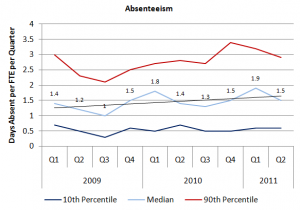Top 10% of Employers Beat Absenteeism Trend
By Ian J. Cook, CHRP
Absenteeism is a key measure for HR. It is a significant driver of HR workload, both from the standpoint of directly managing the health-related absences and dealing with the staffing repercussions that come from absences.
Absenteeism is on the rise and has increased comparatively on a quarter-by-quarter basis since the HR Metrics Service started in Q1 of 2009. The chart below shows the median (or midpoint), the 90th percentile (or highest 10 per cent) and the 10th percentile (the lowest 10 per cent). Notwithstanding the health scares of 2009 and the Winter Olympics in 2010, the trend in absence is continuing to rise.
Much has been talked about the ageing workforce and the health needs of the generation Y. Far from being a prediction about what is coming, the data suggests that this is now a reality. Organizations who do not have a strategy and process in place to effectively promote good health and support high levels of work commitment will increasingly find themselves spending time and money managing absences. The amount of money involved is significant. Based on the median labour costs recorded in our database, organizations with absences at the median are spending more than $1,000 per Full Time Equivalent (FTE) a year more on non-productive time than their counterparts in the top ten per cent. The difference between the top ten per cent and the worst ten per cent is even greater at around $3,000 per FTE.
An increase in absenteeism has also been linked to an increase in people choosing to leave their employer. Over the same period, the resignation rate recorded by the HR Metrics Service has increased. This brings a further increase in HR workload as the vacancies created by resignations need to be filled and overtime is generated to cover the work while the person is replaced.
This rise in absenteeism also suggests a decline in overall employee commitment, a finding supported by recent research suggesting that one in three Canadians would leave their jobs if the opportunity arose.
Combined, these factors suggest that the people side of business has not fared well over the last two and a half years. This recessionary phase of the world economy has brought many stresses and strains and reduced the commitment and buy-in of many staff. This lack of attention to the people side of business is generating its own set of costs. They are less tangible, but nonetheless substantial.
The world economy looks set to travel a rocky road for some time to come. Increasingly, organizations are relying on their key people to find the best path, avoid the pitfalls and lead others to smoother ground. The trend in absenteeism suggests the majority of organizations have some way to go in promoting healthy work habits and generating a high level of employee commitment.
Throughout his career Ian J. Cook, MA, MBA, CHRP, has pursued his fascination with people and business. During his early career, Ian was both an entrepreneur and an operational manager. These experiences led him into consulting on organizational effectiveness, a path he followed for 10 years while serving some of the world’s leading organizations. Ian has established a reputation as a strategic business builder who is far-sighted and thought-provoking.
The HR Metrics Service is now in its third year of operation. With a participation group that stretches coast to coast, represents the broad Canadian economy and over 160,000 employees, the trends and outputs from the service are generating valuable insight for HR groups in BC and beyond.









